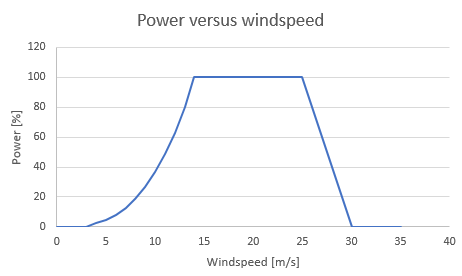A wind turbine is an element that delivers power based on the wind speed.
The power of the wind turbine
The electrical power supplied by the wind turbine is a function of the wind speed.
At a wind speed between cut-in and nominal, the power is a third power function of the wind speed.
At a wind speed between nominal and cutting-out, the power is the nominal power.
At a wind speed between cutting-out and cutted-out, the power decreases from nominal to zero with increasing speed.
The wind speed is given at a height of 10 meters.
The wind speed at the height of the hub is calculated according to: vas := v10 * (hubheight/10)0,143 .

Parameters
General
Parameter |
Default |
Unit |
Description |
Name |
|
|
Wind turbine name |
Number of |
1 |
|
Number of windturbines |
Wind speed |
14 |
m/s |
Actual wind speed at 10 meter height |
Profile |
Default |
|
Wind speed profile |
Hub Height |
30 |
m |
Height of the wind turbine hub |
Pref |
0 |
MW |
Active power per windturbine |
Wind turbine
Parameter |
Default |
Unit |
Description |
Type |
|
|
Type of the wind turbine |
Unom |
|
kV |
Nominal voltage |
Snom |
0 |
MVA |
Nominal power per windturbine |
Ik/Inom |
1 |
|
Relation between nominal power and short-circuit power |
R/X |
0,1 |
|
R/X-ratio during short-circuit |
Cut-in windspeed |
3 |
m/s |
Windspeed for which the wind turbine cuts in |
Nominal windspeed |
14 |
m/s |
Windspeed for which the wind turbine delivers nominal power |
Cutting-out windspeed |
25 |
m/s |
Windspeed for which the wind turbine starts reducing the output power |
Cutted-out windspeed |
30 |
m/s |
Windspeed for which the wind turbine cuts out |
Controls
Parameter |
Default |
Unit |
Description |
Q-control |
const. cos |
|
Type of reactive power control |
cos phi |
1 |
|
Power factor |
U |
|
pu |
Input van de Q(U)-function or P(U)-function |
I |
|
pu |
Input of the P(I)-function; directional |
f |
|
Hz |
Input of the P(f)-function |
P |
|
pu |
Input of the Q(P)-function or output of the P(U)- or P(I)-function |
Q |
|
pu |
Output of the Q(U)-function or Q(P)-function |
No P, then no Q |
not |
|
No Q if P<1 % |
P(U) control |
|
|
P(U) control present |
P(I) control |
|
|
P(I) control present |
P(f) control |
|
|
P(f) control present |
Measure field |
|
|
Measurement field where the current is measured (maximum 3; the most restrictive one prevails) |
Reliability
Parameter |
Default |
Unit |
Description |
Failure frequency |
0 |
per year |
Mean number of occurrences that the zigzag coil fails (short circuit) |
Repair duration |
0 |
minutes |
Mean duration of repair or replacement |
Maintenance frequency |
0 |
per year |
Mean number of occurrences that the zigzag coil is in maintenance |
Maintenance duration |
0 |
minutes |
Mean duration of maintenance |
maint. cut-off duration |
0 |
minutes |
Mean duration of cancellation of maintenance in case of emergency |
Modelling
Short circuit calculations
The wind turbine contributes to the short-circuit current.
Harmonics
The wind turbine is modelled with the corresponding machine-impedances. The harmonic currents of the converter based wind turbine configurations are not yet taken into account.